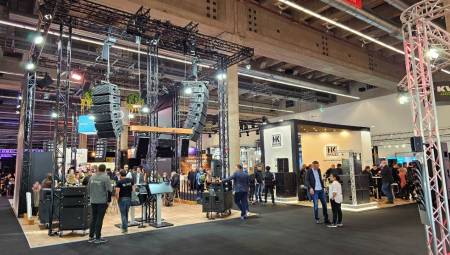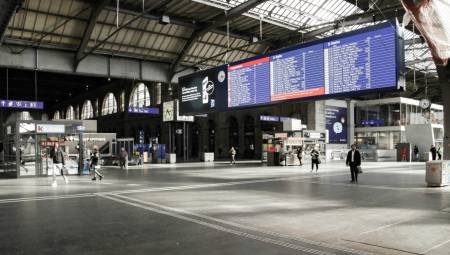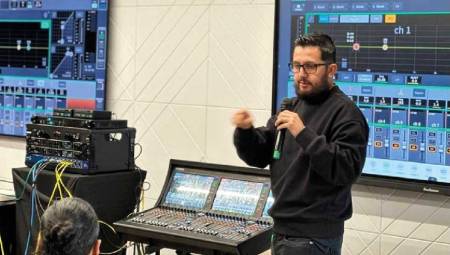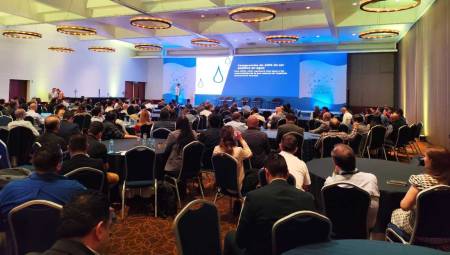During the design process, it is of utmost importance to have an audio signal distribution, conversion, and routing system.
Diego Cárdenas*
Digital audio has been one of the most important innovations in the history of our industry, and it was implemented in all kinds of applications (from recording to high-performance live events). The incorporation of standards and the development of media transmission technology under this infrastructure opened the door for the implementation of more robust, reliable, and fail-safe systems.
Electronic devices such as DSP processors, amplifiers, and digital consoles were some of the first to feature a multi-channel audio stream. Today, we have amplified systems that include digital amplification cards in conjunction with network audio streaming in compact modules, along with third-party controllability.
Network audio has reached a point of evolution where it is possible to have maximum scalability and flexibility in signal distribution in installation projects, live audio and other markets, and even to have real-time processing tools.
How can we get the most out of this technology? Let's look at some important aspects.
Advantages. Only advantages
Multi-channel digital audio transmission over standardized network infrastructure, compared to a traditional analog signal stream, offers a significant number of technological advantages. From an objective and technical point of view, moving any system or project to this model adds a significant number of virtues, such as:
Multi-Channel Streaming
Routing and Flow Allocation via Software Tools
Immune to interference
Low latency levels
Unified Connectivity
Implementation Cost Savings
Do we have compromises or sacrifices when it comes to implementing audio over IP compared to an analog ecosystem? Not really (considering the standards under which the implementation of AV technology is set in our current industry). Migrating from Traditional Systems to Audio over Networks
Compatibility and Unification of Solutions
Day by day, audiovisual projects and the implementation of professional audio systems have begun to be upgraded to network protocols. This shift has happened across multiple markets and apps. However, there are two questions that may arise from users:
 Is my new Network Audio system compatible with my traditional system or at least a section of it?
Is my new Network Audio system compatible with my traditional system or at least a section of it?
Can I create hybrid systems between analog/digital audio under traditional infrastructure?
The answer to both questions is: Of course! It's one of the biggest advantages of Audio over Networking. To date, hundreds of manufacturers of professional audio devices and technology have developed modules that support multiple protocols, allowing for full integration. Audio over Network means interoperability between devices from multiple manufacturers for the benefit of the user.
During the design process, it is of utmost importance to have an audio signal distribution, conversion, and routing system. Generally, we find all these features in DSP processors (open or closed architecture) that allow, thanks to a centralized chassis design, multiple cards or modules of different audio protocols (including analog audio, digital protocols and network protocols). The user's choice should be based on the number of channels required and the routing, programming, and digital processing capacity required for each specific application.
Which protocols or standards are best suited for each project?
Network Audio, in its many variants, sets different guidelines regarding its optimal uses in all types of deployments: from multi-zone commercial audio to robust PA systems in dedicated venues and live event applications.
Selecting the right protocols/standards should consider multiple factors:
- Infrastructure requirements (in the case of IP protocols, there are specific parameters on transmission speed, bandwidth, among others.)
- Wiring distance restrictions (according to standards set by the protocol developer)
- Number of audio channels (linked to sampling parameters, synchronization between devices, and proprietary layout).
In either case, the system design process now has a flexibility and scalability component. A project's network infrastructure can be used to integrate multiple protocols and multiple devices without the need to rethink a project's deployment or labor. Extensive modular and cross-functionality capability across technologies delivers a level of efficiency never before seen under traditional audio streaming.
Integration with other technologies (Video & Automation)
Because digital audio can be transported through the same network infrastructure used for the implementation of other technologies (considering the guidelines of each protocol and standard), it is entirely feasible to incorporate signal flow into integrated solutions that include third-party intervention: such as Video over IP, Control, Automation, Alarm and Video Surveillance Systems, as long as the bandwidth specifications necessary for optimal operation are met.
Undoubtedly, Audio over Networks sets a new horizon for industry professionals. Constant training and training on standards and protocol updates are a determining factor for engineers, designers and integrators of specialized solutions, since the future of audio is linked to their evolution.
Diego Cárdenas is a Specialist Consultant for AV & Acoustics.
















